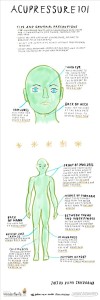First of all, let us say that no one should ever attempt to perform real acupuncture on themselves, or on anyone, without real training. The theories and protocols of acupuncture are very complicated and take years to learn. Currently, the entry-level training requirements for becoming an acupuncturist are either a 3-year Master’s program in acupuncture, or a 4 year degree in Oriental medicine which combines instruction on acupuncture and Chinese herbal treatments. But there are a few tricks based on the fundamentals of acupuncture that you can use at home! And if you try these and like it, you ought to see what a licensed practitioner with 45 years of experience can accomplish!
Acupressure
Acupressure utilizes the same “acupoints” as acupuncture but without actually penetrating the skin. Instead, just pressure is applied, using either the fingers or a blunt instrument.
Acupoint 1: Earlobes
Perfect for: Stress
Your earlobes are a very sensitive part of your body, but they’re also tough, making them perfect for acupressure. If you’re feeling stressed out or overwhelmed, try grasping your earlobes between your thumb and the knuckle of your index finger and gently but firmly pulling down. Hold for several minutes while breathing deeply, and you’ll immediately feel better.
Acupoint 2: Brow Bone
Perfect for: Memory
Are you trying to remember where you left your keys, or how old your wife’s parents are? Try a little acupressure! Press with your finger or a firm blunt instrument on your brow bone, right above your eyebrow and in line with your pupil. Press and hold, and your memory will likely improve!
Acupoint 3: Wrist Tendons
Perfect for: Nausea
If you’re seasick, suffering from morning sickness or the flu, or maybe you had a bad plate of food, try this pressure point to feel better! This point is about two inches below where your wrist bends, in between the tendons. The best way to gauge the exact location is to imagine the distance of your forearm cut in half, and then the half near your wrist cut into thirds. One third down from your wrist bend is your acupressure point. Press for a minute or two on each wrist where it feels most tender, and voila!
If you’re interested in the effects of acupressure or acupuncture, come in to our clinic! Here at Washington State Acupuncture and Chinese Medicine Center, our lead practitioner Raymond Y.T. Chan has been practicing for over 45 years, and the things he can accomplish are almost unbelievable.
And for more helpful tips, check out this amazing handmade diagram by Yumi Sakugawa that describes acupressure areas!



